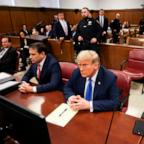The Sound of Silence
Grand Canyon air tours disturbing natural serenity many visitors seek.
GRAND CANYON, Ariz., May 27, 2007 — -- Sunrise is a magical time at the Grand Canyon. The low angle rays of the rising sun, slowly paint the canyon walls light yellow, subtle orange, pinkish red, gray blue and desert tan.
It should be a quiet time. Should be.
But even before the sun peeks over the canyon rim, hundreds of visitors have lined up along the railing above the Bright Angel trailhead to witness the beginning of a new day. They shuffle and chatter among themselves, slurp coffee, and snap photographs. Nearby, mules are saddled up for the journey down the impossibly narrow trail to the bottom. Soon, cars, campers and motor homes (called "land yachts" in these parts) begin arriving to jostle for parking spaces in the turn-out lots.
Then the sounds get serious.
As the morning wears on, helicopter flights take off and buzz over the canyon. And not just a few. At last count, 90,000 flights were authorized to fly over the Grand Canyon. That's nearly double the number since 1987.
"It's kind of like the 'wild west' over some of the parks, said Bryan Faehner, who used to work for the Park Service but now spends his time as a legislative analyst for the nonpartisan National Parks Conservation Association. "This is a growing, growing issue of concern for the National Parks."
And it's not just the Grand Canyon that's become an increasingly noisy place.
Overflights above Haleakala and Hawaii Volcanoes National Parks have also been singled out for "noise pollution." In 2003, more than 24,000 air tour operations occurred at Hawaii Volcanoes National Park, 23,000 at Haleakala. More daunting is the prediction from the FAA that there will be more than two million air tours over our National Parks in the next 10 years.
The soundtrack of our life in the great outdoors is beginning to resemble what we'd hear back home in the city. And then some.
For example, Yellowstone National Park became so inundated with snowmobile noise that all snowmobiles now entering the park must be powered by quieter four-stroke engines instead of their noisier two-stroke predecessors. Still, the unmistakable whine can be heard for miles and miles.




